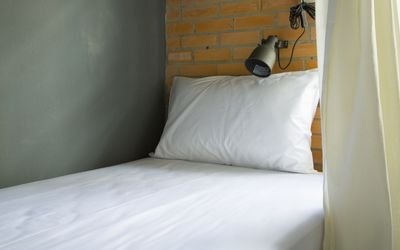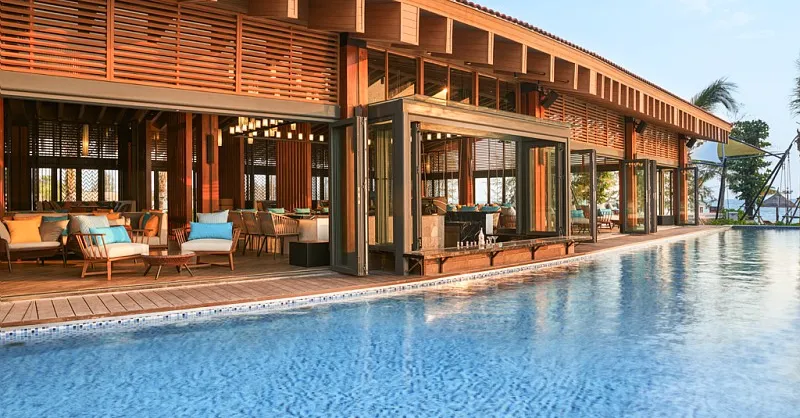When booking hotels, particularly international chains like Marriott or Accor, you may encounter unfamiliar terms for room types, such as Twin Bed, King Bed.
What do these room types in luxury hotels mean? Today, this travel guide will provide detailed explanations.
In international chain hotels, room types are often categorized by bed size and quantity, room level, and view. This provides guests with comprehensive information during their booking process.

For instance, the room type depicted in the above image is the hotel's Superior Room. It features a king bed (approximately 1.93 meters to 2.03 meters in size) .
Let's explore the different types of hotel rooms:
Twin Bed Room

A Twin Bed room type means two single beds are present in the room. It's a common room type in most hotels.
There isn't a standard size for each single bed. Generally, in domestic hotels, single beds usually range from 1.5 to 2 meters, or 1.35 to 2 meters. Some resort hotels may have even larger single beds.
When booking a hotel abroad, particularly in Japan and Hong Kong, it's advised to confirm the bed size before booking. The single beds in some hotels can be quite small. The smallest I've seen is 0.9 to 2 meters, which may not be very comfortable to sleep on.
Double Bed Room

The term “Double Bed” can be misleading as it might suggest there are two beds in the room.
However, “Double Bed” actually refers to a room with one double bed, also known as a double bedroom. This type of room is suitable for couples or pairs. It can also accommodate underage children.
The size of the double beds typically ranges from 1.5 meters to 2 meters, even reaching up to 1.8 meters to 2 meters.
Single Bed Room

A single bed refers to a room with one small bed, suitable for one person only.
These rooms typically have a smaller area and are commonly found in mid to low-end hotels, such as youth hostels and small hotels in Hong Kong or Japan.
If you're booking at a high-end hotel, this room type usually won't be available.
King Size Bed and Queen Size Bed

King Size and Queen Size rooms both feature a single, large bed, larger than those found in standard double rooms. These room types are more common in high-end hotels.
So, what's the difference between King Size and Queen Size?
Internationally, a King Size bed measures between 1.93 and 2.03 meters, hence it's often referred to as a king-size bed. A Queen Size bed measures between 1.52 and 2.03 meters, and as such, it is also known as a queen size bed.
In summary, a King Size bed is larger than a Queen Size bed, but there are no other differences between them.
Primary Variations of Hotel Room Types
Hotel rooms can be sorted by the number of guests they accommodate, such as single, double, triple, quadruple, and so on. Their layout and features also provide a basis for classification:
- Room-only Accommodations: Found in dorm-style hotels, certain inns, bed and breakfasts, and hostels, these offer only the room, with bathrooms and kitchens shared among guests.
- Standard Rooms: Commonplace in motels and most branded hotels, these rooms include a separate bedroom and bathroom.
- Minimalist Rooms: Tailored for tech-savvy, budget-conscious travelers, they emphasize communal spaces and have a smaller personal space.
- Deluxe Rooms: These rooms are more spacious and luxurious than standard rooms, often providing superior views and high-end amenities.
- Studio Rooms: These combine living, sleeping, and dining spaces in a single room, sometimes with a small kitchen area.
- Connecting Rooms: Adjacent rooms connected by interior doors, these create a larger combined space.
- Suites: These accommodations offer separate spaces, including a bedroom, living room, and often a kitchen, for an apartment-style living experience.
Distinct Suite Styles
There are several unique styles within the suite category:
- Standard Suite: Offers a larger space with a separate living area.
- Junior Suite: A smaller version of the standard suite, typically without a physical separation between the sleeping and living areas. It usually includes more than two rooms and a living room in addition to the bedroom.
- Superior Suite: A step above the standard suite in terms of luxury.
- Deluxe Suite: A high-end suite providing luxurious amenities.
- Presidential Suite: The most luxurious suite, often limited in number.
- Penthouse Suites: These suites are usually located on the top floor of luxury buildings, often occupying the entire floor.
- Honeymoon Suites: Catering to couples, these suites are designed with romance in mind.
- Bridal Suites: Offering large, open spaces with flexible work areas, these are suitable for the bridal party's preparations for a wedding.
- Executive Room: This room type includes executive benefits, such as dining in the executive lounge and enjoying happy hours.
Accessible and Special Accommodation Rooms
Hotel rooms can also be categorized based on accessibility and special accommodations for guests with particular needs:
- ADA Rooms: Designed according to the Americans with Disabilities Act (ADA) guidelines, these rooms include amenities such as roll-in showers, visual alarms, and grab bars to assist guests with physical disabilities.
- Connecting/Adjoining Rooms: These rooms, ideal for families or groups, have an interior door that allows guests to move freely between two or more rooms.
- Business Rooms: Catering to the needs of business travelers, these rooms feature a larger work desk, high-speed Internet connection, and often access to the hotel's business center.
- Pet-friendly Rooms: Designed to accommodate guests traveling with pets, these rooms may have easy-to-clean flooring and access to outdoor spaces.
- Allergy-Friendly Rooms: Designed with hypoallergenic materials, these rooms use advanced air filtration systems to reduce allergens.
- Green or Eco Rooms: Designed with sustainability in mind, these rooms use energy-efficient appliances, recycling programs, and eco-friendly toiletries.
Note that the actual names of room types can greatly vary between hotels. Some establishments may use their own creative terms to describe their offerings.
For instance, a “villa” could refer to a large suite, a detached building, or a multi-story penthouse, depending on the hotel. Therefore, it's always advisable to read room descriptions carefully or contact the hotel directly for clarification.
Also some Resort hotels may also classify rooms according to their views, such as Sea View, Lake View, and Garden View rooms.
When booking a hotel, it's recommended to carefully read the room type description, including room size, maximum number of guests, and other details. You can find this information on the booking page. Here's a list of essential websites for travel.

